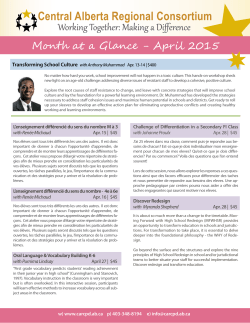
PRESENTATION DU PROJET Recherche Développement
PRESENTATION DU PROJET Recherche Développement 1.1. Intitulé du projet Towards a new Manner to use Affordable Technologies and Social Networks to Improve Business for Women in Emerging Countries 1.2. Identification du projet 1.2.1- Mots Clés 1.2.2 Résumé du projet (250 mots) Incessant enhancement of the role of Information and Communication Technologies (ICT) has been well perceived through the course of events at recent past. Moreover, economic analysis shows companies aim to keep their clients and to promote one to one relationship to increase their sells and their business. Social networks, Web sites, mails, and SMS etc. are using rationally not only to promote their products but also to enhance brand value, to enable strong consumer relations as well as to improve the quality of service and products through receiving feedback from the market itself. However, what is obvious for industrialized countries may not be so for emerging countries. Costs of the devices such as laptops, PDA, software developments to develop Web sites and even simple mobile phones often remain beyond the utmost purchasing capability limit for a wider portion of the population in the developing nations. Moreover, technologies are not disseminated and technical infrastructures such as networks and relay antennas do not cover the whole country. This project specifically aims to address women from both rural and urban areas of emerging low income countries; who are individually or within group involved with sustainable hand craft and/or fair trade business leading to a varying degree of economic mobility. The project is structured into the following steps: - Elicitation: understanding the manner women use new technologies and its socio-economic impacts, Assessing the behavioral patterns related with adopting new technologies; and its temporal change, Analyzing behaviors, Proposing new behavior, technical solutions, and training. 1 1.3. Problématique du projet Sommaire (250 mots) During last past years, several works have been aiming to offer technological products and services in adequacy with means, needs and social habits of populations in emerging countries. These domains concern with well education, health, agriculture, telecommunications, e-commerce, etc. Companies are also trying to enter these markets by using sells strategies along with market structure and its needs (such as rural phone). One of the starting points of these works is the incorporation of the concept of “Base Of the Pyramid”. This concept is based on a simple idea, i.e. 4 milliard people who live with less than few dollars per day represent a set of opportunities in terms of demand of goods and services. These set of opportunities is linked to the “non inclusive” strategies deployed by economic actors, private or public, particularly for emerging countries. The new technologies improve the socio economic situation of this population (Base Of Pyramid) by bringing them information and expertise for consumers and managers. However the results of these works remain limited and a global approach should allow combining a local understanding of habits and needs of this population with a technical expertise of the product or service, and a sectoral expertise. The ‘applied’ part of the global technological innovations in this particular concern is required to be flexible enough that it can be necessarily molded as per the physico-socio-politico-economic characteristics of regional domain of application. 1.4. Objectifs du projet Lister les objectifs scientifiques, techniques, technologiques, socio-économiques et/ou socioculturels. (250 mots) Firstly, this project is based on a global approach based on synergies between specialists in different domains in particular: sociology, economics, computer science, and marketing. It aims to study the impacts of new technologies on populations of both countries, Algeria and Tunisia. Focus to be given on two actors categories: very small companies and members of formal or non formal social networks. Principal aim is to address these two categories and to study the impact of technologies on business activities proposing new habits to use new technologies. Secondly, the result of this study can imply the requirements of new kinds of affordable technologies fitted to emerging countries. Moreover, these new technologies have to be adapted to the profile of the users, for instance, the users can be analphabets and the media have to support text to speech services. The definition of new paradigms for a great part of humanity has the consequences to create start up to commercialize new packaged products and allied services. Thirdly, this project requires to be based on a performing technical infrastructure to analyze information usage and to help users to learn new technologies usage. Moreover, this infrastructure is based on Web services providing service based approach and interoperability between applications. So, proposal may be given to develop and stabilize this architecture to support marketing and social research works, and to promote a true course of actions to help 2 and train women to new technologies and future fitted measures for improving business. 1.5. Description du projet 1.5-1- Etat des connaissances sur le sujet (500 mots) Formally, a social network is a social structure made up of a set of actors (such as individuals or organizations) and the dyadic ties between these actors (such as relationships, connections, or interactions); the connexions between actors can be directed or not, weighted or not; networks of different natures can be combined (multi-level analysis), and some of them can structure the dynamics of the others. A social network perspective is employed to model the structure of a social group, how this structure influences other variables, or how structures change over time. The study of these structures uses methods in social network analysis to identify influential nodes, local and global structures, and network dynamics. Social networks are distinct from information, biological, or electrical networks, but theories and methods generalizing to all of these complex networks are studied in the emerging field of network science (f.ex. Newman et al., 2006, Watts, 2004). Social networks and their analysis is an inherently interdisciplinary academic field which emerged from social psychology, sociology, statistics, physics and mathematical graph theory. Jacob Moreno is credited with developing the first sociograms in the 1930s to study interpersonal relationships as structures in which people were points and the relationships between them were drawn as connecting lines. As recalled by Freeman (2004), the mathematical graph theory is at the heart of development sociometric techniques (social networks analysis) since the late 1940s, more precisely since the pioneering intuitions of Bavelas (1948), Luce and Perry (1949), Smith (1950) and Leavitt (1951), to more formal work of Frank Harary and his colleagues at the University of Michigan (Harary and Norman, 1953, Harary, Norman and Cartwright, 1965). It returned, according to Freeman, to what he calls "the school of the Sorbonne," with Claude Flament (1963) and Claude Berge (1958) mainly, to fix a "first general synthesis explicitly showing that a vast field of social problems could be understood as a special case of a more general structural model" (Freeman, 2004, p. 114). Topological analysis by Claude Ponsard (1968, 1972) and Lantner (1972a, 1972b, 1974), following reflections of François Perroux on power phenomena in economics (1973/1994 for a summary), is the more concrete manifestation of this research tradition in the field of political economy. In this project proposal may be given to to apply new tools directly issued and developed from the Lantner’s work. In doing so, the study will deal with the problems of the formation and dynamics of "(socio-economic) communities" (cf. Newman et al.). The study may necessitates to combine the tools of the mathematical graph theory with qualitative treatments (e.g. Wellman et al.) designed to identify local usages of ICT, their transformations over time, and how these transformations reconstruct the personal networks. Ultimately, sociometric analysis will serve as a basis for assessing the implementation of hardware and software tools promoted by the project at the economic and social levels. 3 1.5-2- Méthodologie détaillée (300 mots) Pragmatically, the project will be divided into four main steps as follows: - Firstly, the behavior of Tunisian and Algerian professionals is observed and the way to use of new technologies as well as social and commercial spheres will be studied. These behaviors are based on formal and informal knowledge to collect and analyze qualitative and quantitative data with rules. These techniques were already used to collect qualitative and quantitative data. Knowledge on Algerian and Tunisian professionals will be modeled, structured and validated according to business experts, computer scientists, marketing experts and sociologists. Sociologists, marketing experts and computer scientists provide a behavioral and habits patterns repository proposing and improving fitted solutions to facilitate the integration of new technologies and social networks during commercial transactions initiated by professionals. These knowledge are parameterized, aggregative, changeable, modifiable and flexible, according to functional, non functional, and technical needs, but also according to ambient context, economical and social environment. - Secondly, the study will link the current behavior of professionals faced to new technologies and social networks to offer solutions or improvements. - The third step proposes to dynamically updated users’ profiles and behavioral patterns through the data from data mining analysis, data warehouse, marketing analysis and sociometry. This approach is iterative and incremental according to the manner users appropriate new technologies and social networks usage. New manners are proposed with feed backs. In the same time innovative approaches and/or technologies is to be framed. - The fourth step proposes to use innovative solution defined in the third step, to check the way it is appropriated and to train people to improve their business. 1.5-3- Principales références bibliographiques Computer Science Jean-Marc Mercantini, Nicole Tourigny, Eugène Chouraqui, « Élaboration d’ontologies à partir de corpus en utilisant la méthode d’ingénierie des connaissances KOD », 1ères Journées Francophones sur les Ontologies, JFO 2007. Monticolo, D « une approche organisationnelle pour la conception d’un système de gestion des connaissances fondé sur le paradigme agent», these, France 2007 Schreiber, A., Th., A.H., Anjewerden, A., de Hoog, R., Shadbolt, N., van de Velde, W., Wielinga, B.: Knowledge Engineering and Management: The CommonKADS Methodology. The MIT Press, Cambridge (1999) Tacla C., De l’utilité des systèmes multi-agents pour l’acquisition des connaissances au fil de l’eau, thèse soutenue en 2003. Sociology Alter N. (2000). L'innovation ordinaire. Paris: PUF. Bavelas A. (1948). A mathematical model for group structures. Applied Anthropology 7(3): 16-30. Berge C. (1958). Théorie des graphes et ses applications. Paris: Dunod. 4 Bonacich P. (1972). Factoring and weighting approaches to status scores and clique identification. Journal of Mathematical Sociology 2: 113-120. Bonacich P. (1987). Power and centrality: a family of measures. American Journal of Sociology 92: 1170-1182. Bonacich P., Lloyd P. (2001). Eigenvector-like measures of centrality for asymmetric relations. Social Networks 23: 191–201. Boorman S., White H. (1976). Social structure from multiple networks: II. Role structures. American Journal of Sociology 81: 1384-1446. Borgatti S.P. (2002). Network NetDraw visualization. Analytic Technologies. Harvard (MA). Borgatti S.P., Everett M.G. (2006), A graph-theoretic framework for classifying centrality measures. Social Networks 28(4): 466-484. Borgatti S.P., Everett M.G., Freeman L.C. (2002). Ucinet for Windows: software for social network analysis. Harvard, MA: Analytic Technologies. Brown J.S., Duguid P. (2001). Knowledge and organization: a social practice perspective. Organization Science 2001 12: 198-213. Burt R.S. (1982). Toward a structural theory of action. New York: Academic Press. Coleman J.S. (1973). The mathematics of collective action. Chicago: Aldine. Duguid P. (2005). The art of knowing: social and tacit dimensions of knowledge and the limits of the community of practice. Information Society 21: 109-118. Everett M.G., Borgatti S.P. (1994). Regular equivalence: general theory. Journal of Mathematical Sociology 19: 29-52. Flament C. (1963). Applications of graph theory to group structure. Englewood Cliffs (NJ): Prentice-Hall. Freeman L.C. (1979). Centrality in social networks: conceptual clarification. Social Networks 1: 215-239. Freeman L.C. (2004). The development of social network analysis: a study in the sociology of science. Vancouver: Empirical Press. Friedkin N.E. (1991). Theoretical foundations for centrality measures. American Journal of Sociology 96: 14781504. Girvan M., Newman M.E.J. (2001), Community structure in social and biological networks, arXiv:condmat/0112110v1. Granovetter M.S. (1973). The strength of weak ties. American Journal of Sociology 78: 1360-1380. Granovetter M.S. (1974). Getting a job. A study of contact and careers. Cambridge (MA): Harvard University 5 Press. Harary F., Norman R.Z. (1953). Graph theory as a mathematical model in social science. University of Michigan Press: Ann Arbor (MI). Harary F., Norman R.Z., Cartwright D. (1965). Structural models: an introduction to the theory of directed graphs. New York: John Wiley & Sons. Hubbell C.H. (1965). An input-output approach to clique identification. Sociometry 28: 377-399. Katz L. (1953). A new status index derived from sociometric analysis. Psychometrika 18: 39-43. Lantner R. (1972a). Recherche sur l’interprétation du déterminant d’une matrice input-output. Revue d’Economie Politique 82: 435-442. Lantner R. (1972b). L’analyse de la dominance économique. Revue d’Economie Politique 82: 216-283. Lantner R. (1974), Théorie de la dominance économique, Dunod, Paris. Lantner R. (1996). La dominance informationnelle. Document de travail du CEIS-METIS – CNRS/Université Paris 1 Panthéon-Sorbonne 1996-73. Lantner R. (2000). Une mesure de l’interdépendance générale dans les systèmes linéaires. Mimeo. CRIFESMATISSE – CNRS/Université Paris 1 Panthéon-Sorbonne. Leavitt H.J. (1951). Some effects of certain communication patterns on group performance. Journal of Abnormal and Social Psychology 46: 38-50. Lebert D. (2010). Théorie des graphes d’influence et analyse des réseaux sociaux : topologie du commerce international de biens industriels – 1980-2004. Colloque international annuel UNECA / OMC. Rabat (Maroc), novembre. Lebert D., El Younsi H., Gallo J., Lequeux F., Zyla E. (2009a). Les échanges industriels entre les pays du bassin méditerranéen : application d’un nouvel algorithme de clustering sur données de flux. In H. Ben Hammouda, N. Oulmane, R. Sandretto (dir.). Emergence en Méditerranée : attractivité, investissements internationaux et délocalisations. Paris: L’Harmattan. Lebert D., El Younsi H., Lequeux F. (2009b). Des Etats-Unis aux pays du Maghreb : les cheminements de la crise. A paraître in Sandretto R. (dir.). Crise, commerce et devenir des économies émergentes en Méditerranée. Paris: L’Harmattan. Lebert D., El Younsi H., Lequeux F. (2010). La dynamique des échanges sectoriels de l’espace économique méditerranéen sur longue période. Rapport ANR MLSN (Réseaux Sociaux Multi-Niveaux). Programme Réseaux du Futur et Services – VERSO. Coordonné par l’Université Paris-Sud 11. Leicht E.A., Newman M.E.J. (2007), Community structure in directed networks, arXiv:0709.4500v1 6 [physics.data-an]. Luce R., Perry A. (1949). A method of matrix analysis of group structure. Psychometrika 14: 95-116. McAuley J.J., da Fontoura Costa L., Caetano T.S. (2007). The rich-club phenomenon across complex network hierarchies. arXiv:physics/0701290v1. Newman M.E.J. (2004a). Fast algorithm for detecting community structure in networks. arXiv:condmat/0309508v1. Newman M.E.J. (2004b). Detecting community structure in networks. European Physics Journal B 38: 321330. Newman M.E.J. (2005). A measure of betweenness centrality based on random walks. Social Networks 27: 3954. Newman M.E.J. (2006). Modularity and community structure in networks. arXiv:physics/0602124v1. Newman M.E.J., Barabasi A.-L., Watts D.J. (2006). The structure and dynamics of networks. Princeton, NJ: Princeton University Press. Newman M.E.J., Girvan M. (2004). Finding and evaluating community structure in networks. Physical Review E 69: 026113. Orlikowski W.J. (2007). Sociomaterial practices: exploring technology at work. Organization Studies 28: 14351448. Perroux F. (1973/1994). Pouvoir et économie. Paris: Dunod. Repris dans Pouvoir et économie généralisée. Grenoble: PUG. Ponsard C. (1968). De l’influence des paramètres singuliers ou le comportement d’un système linéaire de flux interrégionaux. Revue d’Economie Politique 78 : 567-605. Ponsard C. (1972). (dir.) Graphes de transfert et analyse économique, numéro spécial de la Revue d’Economie Politique. Paris: Editions Sirey. Rallet A., Guesmi S., Lebert D., N'Guessan P. (2008). L’impact de l’utilisation d’outils de coordination décentralisés sur les collectifs de travail, les formes de l’encadrement et le processus d’innovation. Rapport d'étape post-enquête COI 2006. ADIS Université Paris-Sud 11 – DARES. Rallet A., Guesmi S., Lebert D., N'Guessan P. (2009). L’impact de l’utilisation d’outils de coordination décentralisés sur les collectifs de travail, les formes de l’encadrement et le processus d’innovation. Rapport final post-enquête COI 2006. ADIS Université Paris-Sud 11 – DARES. Reichardt J., White D.R. (2007). Role models for complex networks. European Physical Journal B 60: 217224. 7 Smith S. L. 1950 Communication pattern and the adaptability of task-oriented groups: an experimental study. Cambridge, MA: Group Networks Laboratory – Research Laboratory of Electronics. Massachusetts Institute of technology. Wasserman S., Faust K. (1994). Social network analysis: methods and applications. Cambridge, Cambridge University Press. Watts D.J. (2004). The “new” science of networks. Annual Review of Sociology 30: 243-270. Wellman B., Quan Hasse A., Witte J., Hampton K. (2002). Capitalizing on the Internet: network capital, participatory capital, and sense of community. In Wellman B., Haythornthwaite C. (eds). The Internet in everyday life. Oxford: Blackwell. White H., Boorman S., Breiger R. (1976). Social structure from multiple networks: I. Blockmodels of roles and positions. American Journal of Sociology 81: 730-780. Marketing Prahalad, C. K. & Hart S.L. (2002): The Fortune at the bottom of the pyramid, Strategy +Business, 26 (first quarter), p.2-14. Prahalad, C.K. (2004), The fortune at the bottom of the pyramid. USA: Wharton School Publishing. Allen et al. (2007), The next 4 million: Market size and business strategy at the base of the pyramid, World Resources Institute-International Finance Corporation, 151p Rolf Wustenghagen, Maaarten Wolsink, Mary Jean Burer, “Social Acceptance of renewable energy innovation: An introduction to the concept”, Energy Policy, 23 (2007), 2680-2691. Yin (2003).Robert K, Case Study Research: Design & Methods, Third Edition, Sage publications, 2003. Results of IAE Wind Task 28 on Social Acceptance of Wind Energy, IAE Wind Task 28, Technical Report, 2010. 1.6. Impacts attendus Impacts directs et indirects (Scientifiques, socio-économiques, socioculturels) Benefits are numerous. Firstly, for all the researchers who will find an opportunity to meet and to combine their expertise to propose new solution, to submit publications and research reports. Secondly, for all the students who will work on this project to help finding new solutions and who will find a fitted application for their research work. On top of all, the greatest benefits will be for the women who will be involved on the project to develop their business. And we hope defining a new way to use fitted technologies and to propose all the social and marketing studies to decide investors and companies to propose a new kind of affordable technologies. We also hope proposing a prototype of a futurist technology addressing emerging and poor countries offering a new way to communicate, to learn and to increase business. We shall be helped by associations, Public organisms, etc. Their implications as facilitators, disseminators, financial initiators, etc, make this project 8 more than credible. 1.7. Planning des taches / année Taches 1) T1.1 2) T2.1 3) T1.2 4) T2.2 5) T1.3 6) T2.3 semestre 1 semestre 2 semestre 3 Pour plus de détails veuillez consulter la figure page suivante et/ou l’annexe. 9 semestre 4 10
© Copyright 2025









